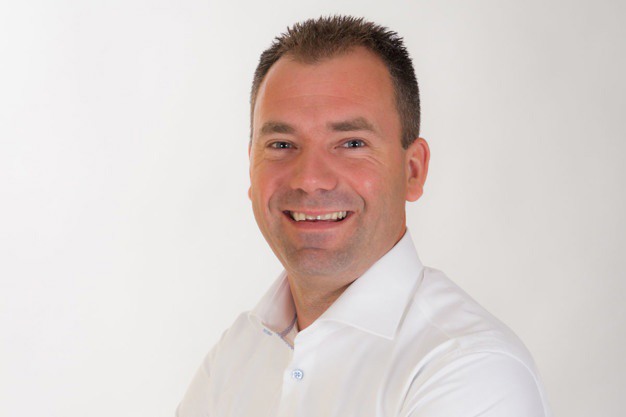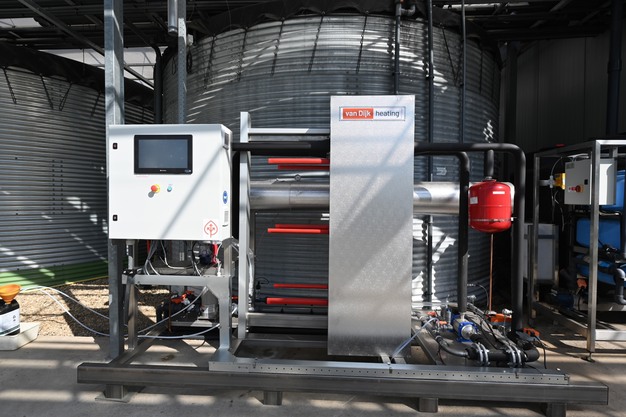This year, Van Dijk Heating celebrates its 50th anniversary. One of the company's early innovations was the Ecoster drain water disinfection unit. The first model was gas-powered, but over the years, the technology has continually evolved. The latest development is a completely redesigned electric version, the Ecoster E, which consumes up to 50% less energy, without compromising on disinfection performance. In fact, the disinfection rate is even higher, emphasizes Managing Director Ton van Dijk: "With the same energy consumption, we can now disinfect not 10, but 20 cubic meters of drain water per hour. That's a significant step forward in efficiency."
Thanks to innovative technology, the Ecoster E consumes significantly less electricity. A small portion of the energy savings has been reinvested to further enhance the disinfection process, fully in line with scientifically accepted standards. The drain water is now heated to 96°C for at least 40 seconds, ensuring 99.95% elimination of microorganisms.
The cooling system has also been upgraded. While current Ecoster models cool the disinfected water to 5°C above the incoming water temperature, the new Ecoster E reduces this to just 2°C above the inlet temperature. This means more heat is extracted from the treated water and fed back into the disinfection process, Ton explains.
"This way, the drain water is also less warm after disinfection. You don't want water that's too hot — that's not good for the roots."
Photo right: Ton van Dijk
 © Van Dijk Heating
© Van Dijk Heating
Economical with assurance
In the Netherlands, the greenhouse sector is on track to reach zero discharge by 2027. More and more growers are already achieving this, with no water being discharged at all. When recycling water, disinfecting drain water is essential in many crops, observes Ton van Dijk, Managing Director of Van Dijk Heating — and a former grower himself. But internationally too, despite differing discharge regulations, disinfecting drain water is becoming increasingly important. "Water is becoming more scarce, so growers need to treat it with care."
The Ecoster E is available in various capacities — 5, 10, 15, and 20 m³/hour — and comes standard with the new energy-efficient technology (ΔT = 2°C). "The energy you don't have to put into the machine is energy you don't have to pay for," Ton says plainly, echoing the kind of logic growers themselves would use.
Depending on the grower's setup, a range of models is available. Gas-fired versions are still an option, as well as models that can operate using hot water from the central heating system — for example, connected to a grower's CHP or boiler. The choice depends largely on the grower's energy costs, which is why Van Dijk Heating always prepares a tailored cost calculation.
"But the higher disinfection temperature we can now reach with these upgraded units is another key advantage," Ton adds. "It provides that extra bit of assurance — which is not unimportant." That same focus on reliability is why they decided not to develop a single unit with a higher capacity than 20 m³/hour. "If you need more capacity, it's better to install two units side by side. That adds an extra layer of security and spreads the risk. You don't get that with one large unit, especially one running on hot water from a central heating system."
For growers who place less value on the lower ΔT, there is also a variant with a ΔT of 4°C available for the 5 and 10 m³/hour models. "These systems have a slightly lower purchase price but consume twice as much electricity."
One of the major advantages of the Ecoster E with the lower ΔT is that its lower energy consumption makes it easier to run on electricity from a grower's own solar panels. And here again, grower logic comes into play: "You irrigate most when the sun is shining — which is also when your solar panels are generating the most power. What could be more logical than running the Ecoster E on that very electricity?"
 © Van Dijk Heating
© Van Dijk Heating
Low maintenance
The updated Ecoster E is easy to install. Commissioning is typically handled by Van Dijk Heating itself, and in most cases, it's as simple as plugging it in. In consultation with the grower, the unit can also be made internet-connected, allowing remote access and monitoring in case of any issues.
"Two models have been running for over six months now. The advantage of the internet connection is that we can easily monitor things remotely, for example, if the flow rate or pressure changes. For growers working with organic substrates, it could be a sign that the heat exchanger needs flushing. Once that's done, the system runs smoothly again. It's easy to detect remotely, and we can advise the grower. What might seem like a malfunction can often be resolved quickly, and by the grower themselves."
In general, the electric heating system requires very little maintenance. "There's no burner, for instance, that needs servicing. With a gas-fired system, just like your boiler at home, you'd still need an annual check-up. That's not necessary here."
 © Thijmen Tiersma | VerticalFarmDaily.comJoek van der Zeeuw and Ton van Dijk at GreenTech Amsterdam next to an animation of the Ecoster E. Not easy to catch in a photo, but the video can be seen at the bottom of this article.
© Thijmen Tiersma | VerticalFarmDaily.comJoek van der Zeeuw and Ton van Dijk at GreenTech Amsterdam next to an animation of the Ecoster E. Not easy to catch in a photo, but the video can be seen at the bottom of this article.
Growers' experience
The Ecoster E was officially introduced at GreenTech in Amsterdam, but two growers were already using the new system before the event. At the breeding company Interplant Roses, the Ecoster E replaced an older gas-fired Ecoster. Interplant is one of a growing number of growers working with organic substrates — a trend also increasingly seen in fruiting vegetable cultivation.
This switch often prompts a critical review of the irrigation setup: is the current disinfection method still effective? With organic substrates, contamination levels can be higher, which may negatively affect the T10 values (a measure of disinfection performance) in drain water.
Ton observes rising interest in water disinfection systems as more growers move to organic substrates. "When switching to a new substrate, the impact on equipment in the water room is sometimes overlooked. Heat-based disinfection is a reliable and robust method, especially for organic substrates." Van Dijk Heating is currently testing the Ecoster E at two potted plant nurseries to further confirm this, as drain water at such sites is often more heavily contaminated with substrate residues.
At Interplant Roses, the management team took its time to explore the latest disinfection technologies when their existing Ecoster unit was due for replacement. UV disinfection was quickly ruled out, as this method is less suitable for drain water containing organic particles, as production manager Victor Piek noted earlier this year: "We grow our young plants in organic substrate, and it's unavoidable that some of that ends up in the drain water. Other disinfection technologies, like reverse osmosis, ultrafiltration, and ozone, all come with technical or financial drawbacks compared to thermal disinfection. So we ultimately came back to Ecoster."
For more information:
Ton van Dijk, General Director
Van Dijk Heating B.V.
sales@vandijkheating.nl
www.vandijkheating.com/ecoster
